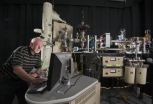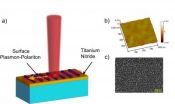(Press-News.org) ALBUQUERQUE, N.M — Sandia National Laboratories is using its Ion Beam Laboratory (IBL) to study how to rapidly evaluate the tougher advanced materials needed to build the next generation of nuclear reactors and extend the lives of current reactors.
Reactor operators need advanced cladding materials, which are the alloys that create the outer layer of nuclear fuel rods to keep them separate from the cooling fluid. Better alloys will be less likely to deteriorate from exposure to everything from coolant fluids to radiation damage.
Operating a reactor causes progressive microstructural changes in the alloys used in cladding, and that can hurt the materials' integrity. However, present-day methods of evaluating materials can take decades.
The IBL, which replaced an earlier facility dating from the 1970s, has been in operation for about a year and is doing in situ ion irradiation experiments, potentially shaving years off testing. The ion beams use various refractory elements to simulate different types of damage and thus predict the lifetimes of advanced reactor claddings. Some of the research was highlighted in a presentation by materials scientist Khalid Hattar in December at the Materials Research Society conference in Boston in a paper co-authored by Tom Buchheit, Shreyas Rajasekhara and B.G. Clark.
Researchers, trying to understand the changes as a function of radiation dose, inserted a beamline from the tandem accelerator, the IBL's largest, into a transmission electron microscope (TEM). This allows them to do in situ ion irradiation experiments at the nanoscale and record results rapidly and in real time. Sandia's lab is one of only two facilities in the U.S. and one of only about 10 in the world that can do this, Hattar said.
"The idea is to come up with new ways to make different alloy compositions and different materials for next-generation reactors and to understand the materials used in the current-generation reactors," he said. "Then we can find ways of doing a combination of TEM characterization as well as small-scale mechanical property testing in this rapid testing scenario to screen these materials and see which ones are the most suitable."
Better understanding of cladding materials could help improve reactor efficiency.
To that aim, Hattar and his team are using the IBL's capabilities to try to gain a fundamental understanding of how the materials evolve in extreme environments at the nanoscale. They hope that understanding can then be related to events on the macroscale.
Take, for example, something familiar like rust on a little red wagon.
"If you look at rust, it's nonuniform," Hattar said. "So the location where that first rust starts to occur must be related to some heterogeneous aspect of the microstructure. If we can really understand on the nanoscale what causes it, that initiating factor, then we can prevent the initiation, and without the initiation, you'll never have that rust formation."
The team developed a system for testing cladding materials that Hattar believes can be used for experiments under extreme conditions to simulate real-life environments. Researchers can work with temperatures up to 1,200 degrees C (2,192 degrees F) and pressure up to one atmosphere as well as ion irradiation to gain basic understanding of radiation damage.
A recently completed Laboratory Directed Research & Development (LDRD) program worked with a variety of samples, everything from high-purity, single-crystal copper to materials used in today's reactors. The team found that under the right conditions, a combinatorial approach can be used with new alloy compositions produced in-house, Hattar said.
The LDRD project demonstrated a fundamental physics simulation of what's happening to the material. In the next step, Hattar has suggested Idaho National Laboratory expose selected materials to neutrons and then try them out in a real reactor. Since the IBL can run experiments in as little as a day, researchers aim to pinpoint the best material so the Idaho lab, whose tests take much longer, won't waste time testing poorer materials, he said.
In one experiment, the team examined both the composition of and effects of radiation on an alloy being considered for the next generation of reactors, seeking the best composition for different radiation exposures.
"Really understanding how the microstructure evolves lets us know a lot about how the material will perform," Hattar said. "So if we can rapidly determine how the microstructure evolves and understand the mechanisms that it evolves by, we could gain a lot of insight into what happens in the material."
That idea prompted the test in which the team connected the large tandem accelerator to the TEM. The tandem accelerator produces the radiation that is sent into the microscope, allowing team members to watch as they irradiate materials. The TEM setup achieves nanometer-scale resolution with results recorded in real time.
In the next generation of testing, the team will have the option of using the beam from a Colutron accelerator recently added to the IBL system.
"This will allow us to do irradiation with both the heavy ions for displacement damage as well as a helium-deuterium combination for understanding hydrogen embrittlement and swelling of the cladding materials," Hattar said.
Once researchers understand those mechanisms, they can go about selecting the proper material for a wide variety of extreme environments where radiation plays a significant role, such as shielding microelectronics from radiation from space.
The in situ ion irradiation TEM includes two new stages that give the IBL even more unique capabilities. A microfluidic stage allows researchers to look at fluids inside the microscope in real time, and a vapor phase environmental cell can be used to study how corrosion occurs as a function of time. The vapor phase studies were made possible by B.G. Clark and Brad Boyce with Basic Energy Sciences funding. The microfluidic stage was supported by Readiness in Technical Base and Facilities, an NNSA program.
Hattar said the team is planning basic science applications to study fundamentals such as oxidation mechanisms in materials, as well as gas phase flow experiments to look at the effects of hydrogen or corrosive gases on samples. The system also can do tomography, which enables the researchers to turn 2-D TEM projection images into full 3-D reconstructions. This results in visualization of the sample from all angles simply by compiling 2-D images taken at a range of sample tilts.
IBL researchers hope to provide fundamental insights into a variety of projects, both at Sandia and externally, that are interested in everything from corrosion to radiation damage to materials, Hattar said.
Experiments, however, are in the early stages because the facility is so new.
"We're sitting in a situation where we're just trying to see where they'll lead right now," Hattar said. "It should be fun and there should be lots of different directions."
INFORMATION:
Sandia National Laboratories is a multiprogram laboratory operated and managed by Sandia Corporation, a wholly owned subsidiary of Lockheed Martin Corporation, for the U.S. Department of Energy's National Nuclear Security Administration. With main facilities in Albuquerque, N.M., and Livermore, Calif., Sandia has major R&D responsibilities in national security, energy and environmental technologies, and economic competitiveness.
Sandia news media contact: Sue Holmes, sholmes@sandia.gov, 505-844-6362
Sandia National Laboratories' Ion Beam Laboratory looks at advanced materials for reactors
2012-03-27
ELSE PRESS RELEASES FROM THIS DATE:
Boston University researchers develop microfluidic chip to stem flu outbreaks
2012-03-27
BOSTON -- The H1N1 flu pandemic in 2009 underscored weaknesses in methods widely used to diagnose the flu, from frequent false negatives to long wait times for results. Now Boston University researchers have developed a prototype of a rapid, low-cost, accurate, point-of-care device that promises to provide clinicians with an effective tool to quickly diagnose both seasonal and pandemic strains of influenza, and thus limit the spread of infection.
Boston University Biomedical Engineering Associate Professor Catherine Klapperich led the team of engineering and medical researchers ...
Researchers discover a new path for light through metal
2012-03-27
WASHINGTON -- Helping bridge the gap between photonics and electronics, researchers from Purdue University have coaxed a thin film of titanium nitride into transporting plasmons, tiny electron excitations coupled to light that can direct and manipulate optical signals on the nanoscale. Titanium nitride's addition to the short list of surface-plasmon-supporting materials, formerly comprised only of metals, could point the way to a new class of optoelectronic devices with unprecedented speed and efficiency.
"We have found that titanium nitride is a promising candidate ...
WTFast.com Destroys Lag and Gives First-Person Shooter Gamers a Competitive Advantage From Anywhere Around the World
2012-03-27
Using unique proprietary technology, WTFast accelerates the online connection between gamers and servers, dramatically increasing performance for the world's most popular franchises. WTFast users can see drastic improvements in performance boosting game connection speeds by as much as 70 per cent. This is vital for gamers who live remotely from the host game servers.
"Our service gives its users a huge advantage in multiplayer FPS games regardless of where you are in the world," said Rob Bartlett, CEO of WTFast. "In some cases we've seen ping rates drop ...
When we test, do we stress?
2012-03-27
Your mother had a doctor's appointment for a memory test. The results are conclusive: she presents with the first signs of Alzheimer type dementia. Now, to get to her appointment, your mother, who is no longer used to driving in town, took her car, looked for a parking space for 15 minutes, got lost in a labyrinth of one-way streets, had never used those new electronic parking meters before and is convinced that the "machine" stole her credit card number. Out of breath, she walked 20 minutes looking for the doctor's office and finally arrived late for her appointment, even ...
Nicaragua Sets New Record in FDI Attraction
2012-03-27
The Government of Nicaragua recently revealed that the country received US$967.9 million in foreign direct investment (FDI) during 2011, a new record for the country in FDI inflows and a 91 percent growth when compared to the US$507.9 million attracted in 2010.
The FDI attracted in 2011 was led mainly by the energy, telecommunications and free zones sectors, which together accounted for 52 percent of total FDI. The development of these sectors has contributed significantly in increasing the country's productive capacity and boosting its economy.
Specifically, in the ...
University of Maryland completes most extensive full face transplant to date
2012-03-27
Baltimore, MD -- The University of Maryland released details today of the most extensive full face transplant completed to date, including both jaws, teeth, and tongue. The 36-hour operation occurred on March 19-20, 2012 at the R Adams Cowley Shock Trauma Center at the University of Maryland Medical Center and involved a multi-disciplinary team of faculty physicians from the University of Maryland School of Medicine and a team of over 150 nurses and professional staff.
The face transplant, formally called a vascularized composite allograft (VCA), was part of a 72-hour ...
Finding reason in delusion
2012-03-27
Dementia -- an acute loss of cognitive ability -- can be marked by memory loss, decreased attention span, and disorientation. It occurs in severe disorders such as Alzheimer's disease. Despite the fact that the condition is common, especially among older persons, there is still a lack of effective treatment.
According to Prof. Jiska Cohen-Mansfield of Tel Aviv University's Herczeg Institute on Aging and Sackler Faculty of Medicine, dementia sufferers are often prescribed psychotropic drugs to mitigate symptoms such as delusions. But this tactic can cause more harm than ...
Corcentric Announces Larry Nemerofsky as Director of Client Integration
2012-03-27
Corcentric, a leading provider of centralized invoice processing solutions for the automotive aftermarket industry, today announced the appointment of Larry Nemerofsky to the role of Director of Client Integration. Larry brings with him more than 30 years of experience in collaborating with corporate and senior-level decision makers to conceptualize business models, formulate strategies, develop effective cross-functional relationships, and solve business problems.
Previously, Larry served as Director, Customer Advocate Team at Cardone Industries, where he was responsible ...
Study of employee substance use shows the need for supervisor training
2012-03-27
BUFFALO, N.Y. -- To curb employees' on-the-job substance use and intoxication, bosses need to do more than just be around their employees all day, according to a new study from the University at Buffalo Research Institute on Addictions (RIA).
"It's only when employees think their supervisor knows how to detect substance use -- and is willing to do something about it -- that employees' drinking and drug use on the job decreases," explains Michael Frone, PhD, senior research scientist at RIA and research associate professor of psychology.
"Contact with a supervisor, ...
Sleep apnea puts patients at risk for delirium after surgery
2012-03-27
DURHAM, N.C. – An anecdotal observation of a possible link between sleep apnea and post-surgical delirium has been measured and confirmed by a team of researchers at the Duke University Medical Center.
"The association between sleep apnea and postoperative delirium is big news because it may offer us a way to control postoperative delirium which can be devastating," said senior author Madan Kwatra, Ph.D., who is associate professor of anesthesiology at Duke.
The study appears in the April 2012 issue of Anesthesiology.
Delirium is not a minor consequence. The condition ...


